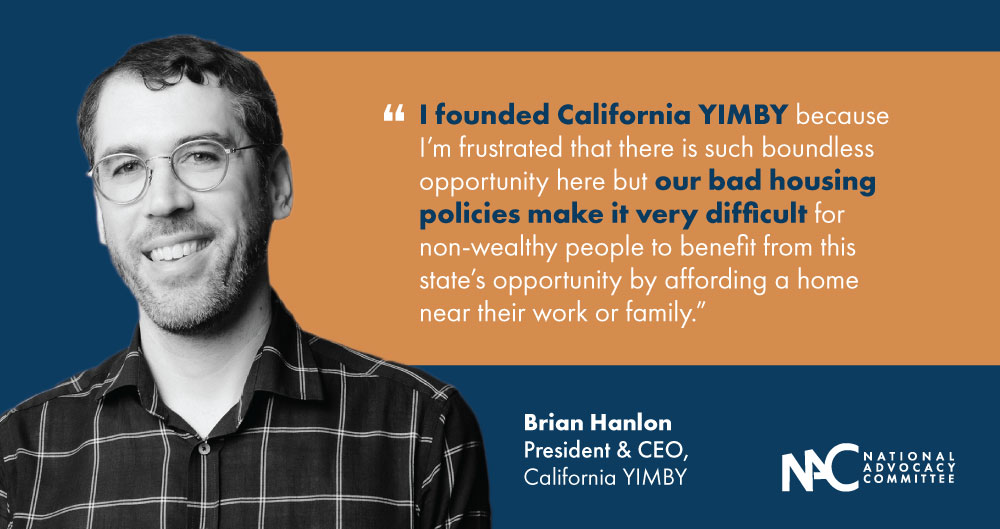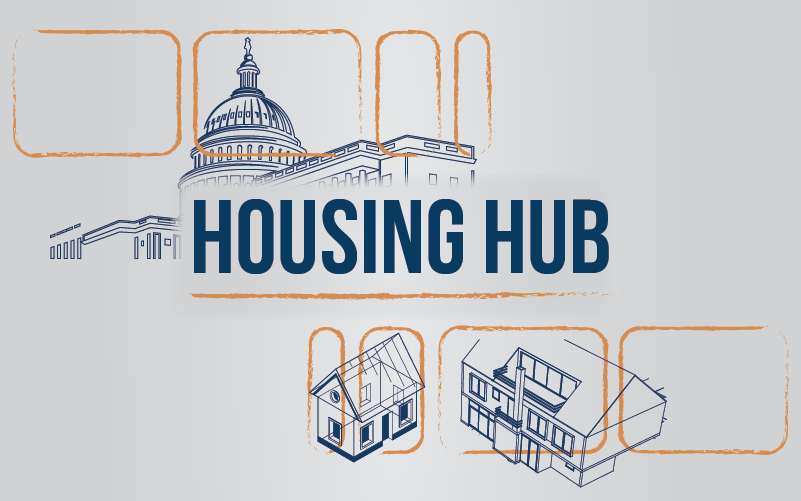Yes In My Back Yard, turning thoughts into action
Celebrating NAHREP familia, cultura, politics, and grassroots action
March 18, 2021
Qué onda mi gente?!
In the business of “change making” or advocacy, we seldom ever do anything alone. We need partners. The first step in laying out a strategy is to figure out who our friends are and who will join us in battle.
As housing inventory continues to be the number one barrier to advancing sustainable Hispanic homeownership, the situation in California is probably the most severe. But at the same time, the advocacy community around housing production is also the most organized. One of the leading voices on housing inventory in the state of California is our friend Brian Hanlon, the President & CEO of the Yes In My Back Yard (YIMBY) initiative. California YIMBY is an organization that works to directly fight what has been coined as “NIMBYism”, the Not-In-My-Back-Yard movement, or vocal citizens and advocacy groups that oppose the building of anything in their neighborhood.
California YIMBY and NAHREP have partnered together to take on housing inventory challenges in California. I wanted to have you all hear directly from him, particularly because we need to start similar initiatives in other states. California is not the only state with a housing shortage. As Latinos continue to drive demand for housing across the nation, our involvement and our voice is more important than ever.

Q: Tell us about California YIMBY and what inspired you to found it?
Brian: California YIMBY is a statewide advocacy organization that works to make California affordable for everyone to live, work, and raise a family. We advocate for legislation to massively increase the rate of homebuilding, especially in areas near jobs and transit. Achieving our mission will put California back on a path of broad-based economic prosperity, creating vibrant, inclusive, and livable communities for everyone.
I founded California YIMBY because I’m frustrated that there is such boundless opportunity here, but our bad housing policies make it very difficult for non-wealthy people to benefit from this state’s opportunity by affording a home near their work or family. I think about the kind of opportunity that this country offered my grandparents, and how their story is much rarer in California today. My grandfather was a tenant farmer in Ireland who didn’t come to the United States until he was 33. For work, he loaded sacks of mail on train cars, did landscaping work over the weekend, and yet was able to afford to buy a home within 6 years of arriving in Boston. You simply can’t afford to buy a home in an expensive city like Boston today on that kind of wage, let alone also provide for a spouse and three kids who went to Catholic school! I believe that California can once again offer the American dream for everyone that my grandfather achieved.
Q: What do you think is the biggest challenge to building more homes in California, both from a policy perspective and from a political perspective?
Brian: From a policy perspective, there are three basic reasons that California doesn’t build enough homes.
- It is illegal to build the kind of more naturally affordable small homes on small lots, or multi-family housing, in most urban neighborhoods in California today. My grandfather’s first house was a duplex. He rented the other unit to nuns (he was *very* Catholic), which enabled him to become a homeowner. Duplexes are illegal in most of California today!
- California does not embrace the rule of law when it comes to home building. Many cities subject homebuilders to convoluted, lengthy, and uncertain housing approvals processes, even if the proposed housing development complies with all local rules.
- Lastly, many California cities impose high fees and expensive requirements on new homebuilding. The middle class will never be able to afford a new home if it costs $150,000 just to get permission to build one little house!
The housing policy status quo is maintained by networks of Not-In-My-Back-Yard (NIMBY) homeowner activists, local elected officials seeking to preserve aldermanic privilege, ideological opponents of market-based solutions, interest groups who benefit from the discretionary housing approval process, and prior to California YIMBY, the absence of advocates dedicated to ending the housing shortage.
Q: What advice do you have for our members that want to do something similar in other states around the country? How should they approach the issue of housing inventory?
Brian: Talk to your fellow real estate professionals and your neighbors about what you’re seeing in your community. I talk a lot (probably too much!) about economic and other social scientific studies that link the lack of homebuilding to widespread unaffordability, but as real estate professionals, you can better humanize the situation by informing your neighbors of local real estate dynamics and how people raised in your neighborhood cannot afford to buy a home there. Once you start talking to your colleagues and neighbors about the housing shortage, you’ll find that many people agree with you. I’d recommend bringing a couple of like-minded friends to a city council meeting or meet with your state representatives and talk to them about your experiences, and ask them to support policies to accelerate homebuilding.
Q: Who is your favorite Latin artist and what is your favorite Latin song?
Brian: That’s an impossible question to answer! I really like El Guincho, whose album Alegranza is such a banger.
I don’t know if The Mars Volta counts as Latin music (they were based in El Paso and sang in English and Spanish), and I don’t listen to them as much as I did when I was younger, but I really respect their artistry and ambition. Their album Deloused in the Comatorium makes them sound like they came from Saturn with Sun Ra, rather than El Paso.
I’ve long enjoyed many artists associated with the Tropicália movement, especially Os Mutantes. They recorded their eponymous debut album when they were only teenagers, and it’s one of the greatest albums of the ‘60s! If I had to pick a favorite song sung in Spanish, it would probably be “El Cuarto de Tula”, performed by Compay Segundo. It’s just stunningly beautiful.
Thank you NAHREP familia. I hope you found this interview informative and will start looking for organizations to partner with on housing inventory in your state. Don’t forget to register to the 2021 NAHREP National Convention and Housing Policy Summit! I’ll see you there.
Un abrazo!

About Noerena Limón
Noerena Limón is NAHREP’s Executive Vice President of Public Policy and Industry Relations. Noerena heads the organization’s policy and advocacy efforts on issues ranging from homeownership, housing inventory, credit access and immigration.
Prior to joining NAHREP, Noerena spent six years at the Consumer Financial Protection Bureau (CFPB) and served as a political appointee under President Obama in the White House Office of Political Affairs.



